When Robert Given left CBRE to become vice chairman of capital markets at Cushman & Wakefield in South Florida last July, it was the culmination of months of courtship.
In October 2015, he and his 11-person multifamily team started getting solicitations from competing brokerages. By January 2016, that had escalated to offers from half a dozen firms.
“The combination of this market being very important and multifamily being important, we had gotten on a lot of folks’ radar,” Given said.
Cushman & Wakefield appeared most appealing, due to its access to foreign capital, culture, name recognition and management, he said.
Cushman even flew Given to New York, Atlanta, Los Angeles and Washington, D.C., to meet other top producers who would be part of his network.
“There are very few times in your life when opportunities arrive to make a career move like we did … and we took advantage,” he said.
Given’s move, along with 10 members of his team (one stayed at CBRE), is emblematic of the shifts that have taken place in South Florida’s major commercial brokerages in recent months. Firms are courting and poaching talent from competing brokerages, while brokers are searching for new opportunities amid an evolving market.
Culture, technology and brand, along with financial incentives, are among the key factors driving broker movement.
 When it comes to the latter, splits come into play. Commercial brokers act as independent contractors, whose earnings are derived purely from commissions, “So you eat what you kill,” said Ken Krasnow, executive managing director of Colliers International South Florida, who joined the firm from CBRE in 2015.
When it comes to the latter, splits come into play. Commercial brokers act as independent contractors, whose earnings are derived purely from commissions, “So you eat what you kill,” said Ken Krasnow, executive managing director of Colliers International South Florida, who joined the firm from CBRE in 2015.
The split often starts at 50-50, but depending on performance, the broker’s share can ratchet up to 60 or 65 percent, and even higher. Higher splits can be a good motivation for jumping firms.
“Brokers are entrepreneurial by nature,” Krasnow said, and a firm’s culture can play a role in that. “Some companies are better than others at managing and creating a collaborative and collegial yet competitive culture,” he said. “So in a lot of cases, culture is a big driver of why people look to leave a situation.”
Upward mobility is also an issue. Opportunities may arise for a second or third person on a team to become a lead broker at another firm, for example.
And a brokerage’s geographical reach, capital and willingness to invest in new technologies, programs and software play a significant role too.
“The world is moving so fast that some brokers are attracted to platforms that give them more nimbleness and flexibility and potentially more opportunity,” Krasnow said.
Recruitment packages may include a signing bonus or a loan that might be forgiven if they stay with the company a certain length of time. Most commercial brokers are under contract for five years or longer, he added.
From a firm’s standpoint, “You look at brokerage teams as companies, in and of themselves. And you’re like a venture capitalist, and you’re deciding where am I going to invest my capital?” he said.
Colliers is among the commercial brokerages that have grown the most rapidly in recent months. In December 2014, the firm had 20 people, and today it has about 130, according to Krasnow. Growth has come from acquiring the Pointe Group Advisors, as well as from recruiting teams and hiring individual brokers, including Mika Mattingly from Sterling Equity Commercial and Gerard Yetming from CBRE, who have formed the firm’s urban core division. Colliers also recently hired Jonathan Kingsley and Steven Rutchik, office and industrial brokers, who came from JLL.
“We’ve hired from the big and the small [firms] and everything in between, making sure we are finding the right people who are attracted to our culture and platform and what we are trying to build,” Krasnow said.
 Colliers and Cushman have been most aggressive in recruiting in South Florida, and are among the top beneficiaries of the disruption in the industry and market, insiders say, referring to consolidation and changes in technology.
Colliers and Cushman have been most aggressive in recruiting in South Florida, and are among the top beneficiaries of the disruption in the industry and market, insiders say, referring to consolidation and changes in technology.
“Cushman over the past two years has just been doing an amazing job at recruiting some of the top producers, and most of these guys are coming from CBRE,” said Anthony Librizzi, who joined Cushman in early May from CBRE.
Larry Richey, Cushman’s Florida managing principal, said Cushman has grown statewide during the last 20 months from 450 staffers to 750, while the number of brokers has jumped to 156 from 75.
“As the commercial real estate service industry has matured, there’s been consolidation at the highest level, mergers and acquisitions, and activity at the regional and local level, and we have grown greatly,” he said. “We have literally doubled our revenue in the last two years in Florida, and tripled our profits,” he said, though he declined to disclose figures for the privately owned company.
Cushman’s September 2015 merger with DTZ created a company with $5 billion in revenue, leading to what Richey calls “a new perception and reality because of the merger and changes in leadership at the very top and all the way down … What some brokers would say is we are one of the last companies that still leans more entrepreneurial in culture than some of our competitors.”
So, taking advantage of the newly capitalized company, the firm began to invest in new talent, and has often found it at competing firms, Richey said.
Since the DTZ merger, Cushman acquired property management and leasing firms Gibson Realty Group in April 2016 and Taylor & Mathis of Florida, led by Brian Gale, in August 2016. The latter was its single largest acquisition with a total of 130 people, including property management and analysis staff and 11 brokers, eight of whom were in South Florida, including Gale and his team, as well as brokers John O’Neil and Donna Korn.
Richey said Taylor & Mathis’ owners had reached out to six firms about acquiring it, and Cushman was not actually the top bidder.
“It comes down to what is the brand? Where is the company in its evolution? Who is leading the company? Is there a good fit?” Richey said. “In South Florida, we have been on an unbelievable roll.”
In addition to bringing on Given and his team, the firm hired Troy Ballard from ARA Newmark; he is now a senior managing director on that team.
Other hires included Deanna Lobinsky and Travis Herring, along with Katherine Ridgway, in late 2015 in Fort Lauderdale. All three were from CBRE, and Richey called them the top office landlord representative team in Broward County. In addition, the firm hired Chase Kulp from JLL, as well as Jeff Holding and AJ Belt, office tenant reps, who were also from CBRE.
Librizzi calls Richey “the best in the entire state about knowing how to build a team.”

Robert Given and 10 members of his team moved from CBRE to Cushman & Wakefi eld.
“Cushman is definitely more entrepreneurial, and here in West Palm Beach, particularly,” Librizzi said. “It’s a very dynamic group of people. This office has a lot of fun. We work hard and we play hard, and it’s a lot of fun to come into work.”
Richey said part of the firm’s entrepreneurial slant means having less staff in management roles than some of its competitors. “When you let thoroughbred brokers run free, it’s amazing how fast they run,” he said.
Sometimes the recruitment process begins with a Cushman broker who knows a competitor at another firm and convinces the prospect that it’s a great place to be.
“We’re very careful not to violate anyone’s contract; that would tarnish a reputation,” Richey said. “So you have to be very careful and fair and truthful about what you do. You still respect all the competitors, and what goes around comes around.”
Nationwide, CBRE ranks as the largest commercial brokerage by broker head count, with Cushman ranking second and JLL third.
Arden Karson, a senior managing director for CBRE in South Florida who joined the firm in January from the Related Group, doesn’t see poaching from her firm as unusual. CBRE “trains the best talent,” she said.
“Every business organization has people coming and going … It’s a normal course of business,” she said. “When people leave, we have a full bench of people waiting in the wings to take those slots … We don’t have to do a lot of courting. People come to find us.”
In fact, Karson said she was the one who initiated discussions for her own job when she learned the leadership position had become available. She called friends at CBRE and told them she wanted to be considered for the job.
Karson cites CBRE’s investment in technology as among its advantages, and disputes any implication that the publicly traded firm is less entrepreneurial than others.
“One of the things that attracted me to the company is its 85 independent business owners. The ability to work with them and help develop their businesses was intriguing and motivational,” Karson said.
Among CBRE’s recent hires are David Wigoda, senior vice president of CBRE Capital Markets in Miami, who joined from JLL; Paul Ahmed, senior vice president CBRE Capital Markets’ Debt & Structured Finance, based in Fort Lauderdale, who came from Walker & Dunlop; and Chris Smiles, senior vice president CBRE multifamily investment team, who had been with Woolbright Development and joined the firm with his son Cal Smiles as senior financial analyst.
In May, CBRE acquired Brenner Real Estate Group, a Fort Lauderdale-based commercial real estate firm. The acquisition included president and CEO Scott Brenner and a team of 22 employees in Fort Lauderdale, Boca Raton and Melbourne who offered leasing, investment sales and property management services.
Brenner had expressed interest in selling his firm before Karson started at CBRE, and she quickly picked up those talks once she joined. It was a quick courtship, she said, because she knew Brenner well.
“We move fast, we’re entrepreneurial, and this is a perfect example,” Karson said.
JLL, for its part, also made a significant acquisition in December 2015 when it bought Cresa South Florida, a tenant-focused commercial real estate firm. In Miami, JLL added a staff of 30, including 22 brokers, from Cresa. As a result, JLL currently has the largest tenant rep practice in South Florida, said Matthew Goodman, managing director of JLL in South Florida, who was formerly with Cresa.
Soon after the Cresa purchase, JLL brought on Eric Groffman and Josh Gibbons from Transwestern, and the firm also recruited Brian Smith and Audley Bosch, a leading industrial team from Cushman & Wakefield.
“A lot of people come and go in the industry. There’s always a lot of transition for a lot of reasons, but JLL’s focus since we’ve been here is to attract and retain the top talent in the market,” Goodman said.
For Given, who left CBRE for Cushman & Wakefield, the move has been fruitful. Since July, Given and his team have completed at least three-quarters of a billion dollars in deals, and are on their way to their $1 billion annual goal.
“We couldn’t be happier,” he said. “It’s good from time to time to be invigorated and challenged, and it’s given us focus and drive.”
